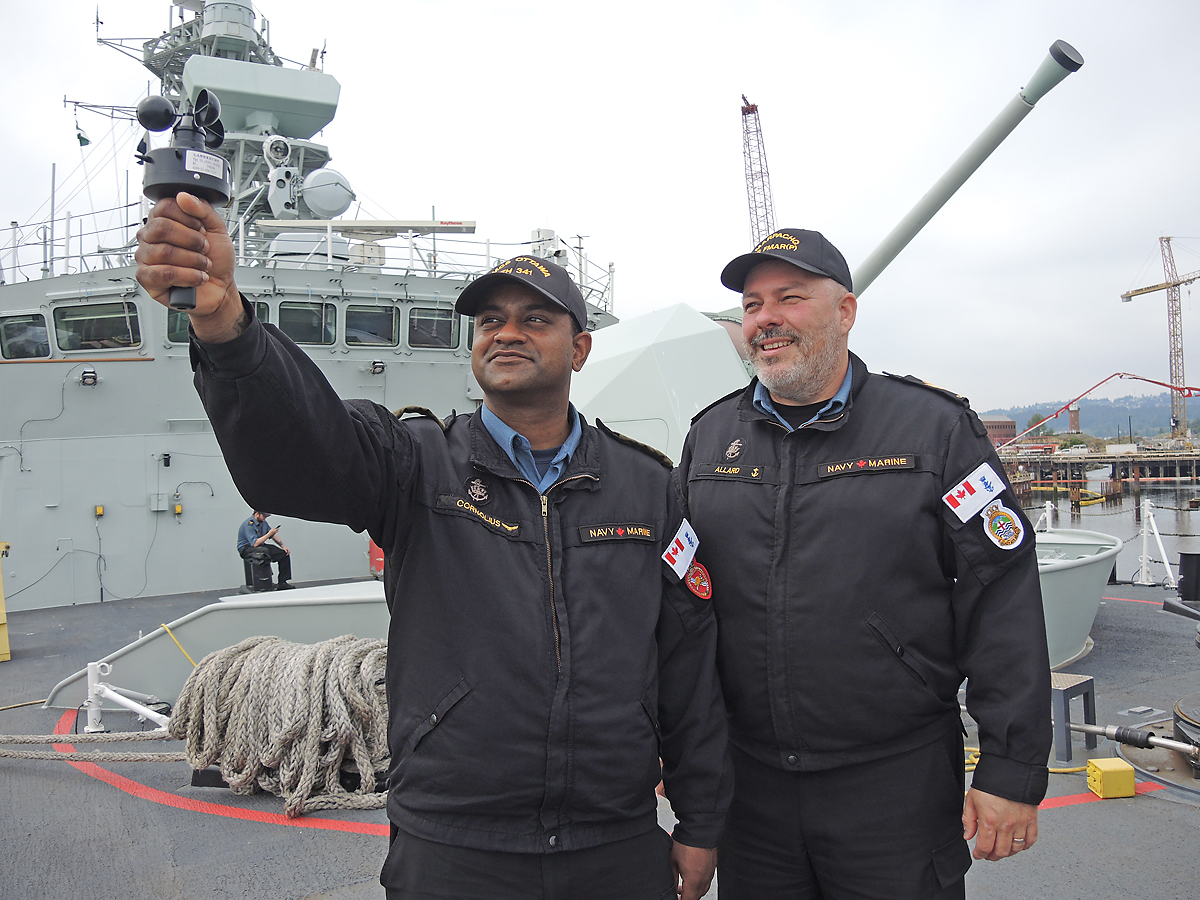First navy Meteorological Technician sails with HMCS Ottawa
By Lookout Production on Jun 13, 2022 with Comments 0

Master Corporal Joe Cornolius, Meteorological Technician with HMCS Ottawa, and Petty Officer Second Class Robert Allard, Meteorological Office Supervisor, measure wind speed on the foc’sle of HMCS Ottawa with an anemometer. Photo: Peter Mallett, Lookout Newspaper.
A new season in weather forecasting begins this week for meteorological technicians serving in the Royal Canadian Navy (RCN).
Petty Officer Second Class (PO2) Robert Allard will become the first navy Meteorological Technician (Met Tech) to sail in active service on HMCS Ottawa.
“To have someone on board in a navy uniform making forecasts is something new,” says PO2 Allard.
The Met Tech trade has existed within the Royal Canadian Air Force for decades, but in 2011 the Canadian Armed Forces (CAF) opened the trade to all elements. Last year, the RCN started seeking candidates for senior positions on frigates. So far, only PO2 Allard and Petty Officer First Class Amanda Pond joined, with PO2 Allard being the first to set sail. PO2 Allard says his posting marks the start of a closer relationship between the RCN and the Met Tech trade.
Met Techs observe and forecast weather in support of operations at various facilities in all three elements. They record, process, and analyze meteorological information, operate and maintain equipment, and brief personnel on weather conditions.
PO2 Allard works as a Supervisor with the Meteorology and Oceanography department of Maritime Force Pacific. On board ships, he notes, the trade is playfully referred to as ‘weather witches’. Met Techs have other responsibilities, including maintenance work, keeping the ship’s stores and ammunition fully stocked, and processing mail.
The Met Tech cohort sailing on ships will increase over time. Uniformed Met Techs need to reach the rank needed to fill senior positions. Occupational training takes six months, with additional six months of advanced training needed to qualify for a ship posting.
An eye to the Sky
Out in the open waters, Met Techs monitor wave heights, the state of icebergs and sea ice four times a day, and conduct observations whenever aircraft is in concert with the vessel.
“The job is more challenging at sea because some of the most advanced computer tools we use at land are not available at sea,” says PO2 Allard.
Met Tech reports are vital to a ship’s command team, says Lieutenant (Navy) Meghan Jacques, HMCS Ottawa’s Navigation Officer.
“We can’t Google the weather in the middle of the Pacific,” she says. “We need to know if we will have a high sea state or winds to determine if the crew can get their jobs done.”
Robert’s Story
PO2 Allard’s evolution into the Met Tech trade was not by design but by circumstance. He served as Naval Warfare Officer until one of his mentors suggested he consider meteorology. He says he was spellbound after realizing he could earn a living by studying the science of weather.
“My thought was, everyone likes to talk about the weather, but the CAF will pay me to become an expert in understanding how weather affects CAF missions,” he says. “I just had to be part of that.”
HMCS Ottawa will sail in Esquimalt waters June 13-27 as part of Tiered Readiness Program. PO2 Allard says it may be his last sail for the foreseeable future. In July, he will be posted to 17 Wing’s Canadian Forces School of Meteorology as a Senior Meteorological Instructor. He will be the first navy instructor at the school.
Filed Under: Top Stories
About the Author:





